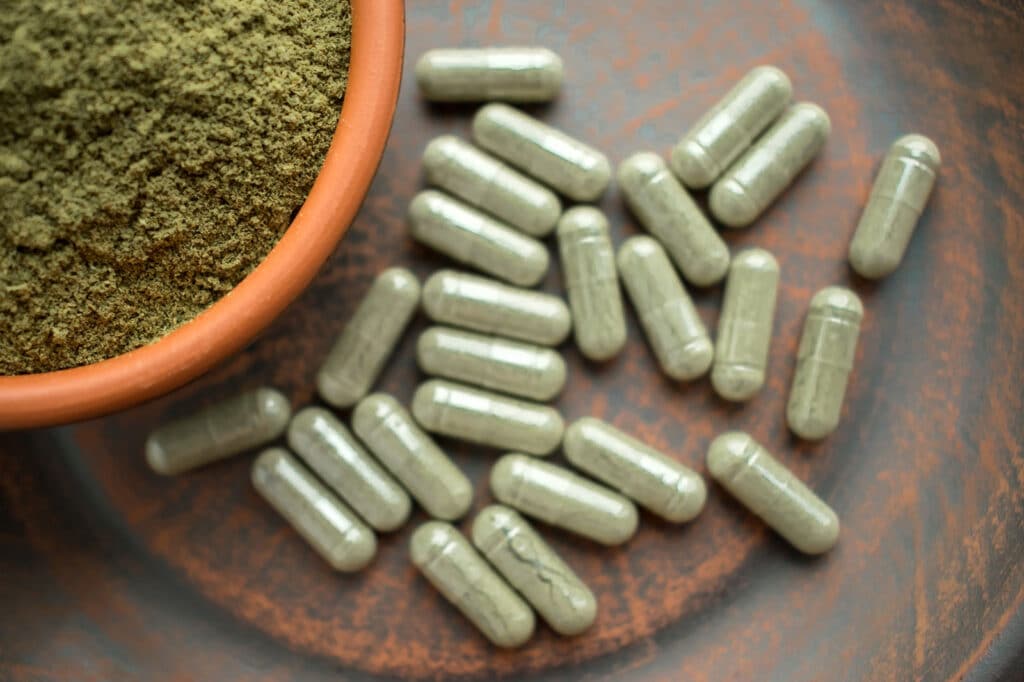For years, kratom was used in its native Southeast Asian region to induce relaxation and provide energy. Some people even began to use it to self-treat pain, especially the one caused by substance use disorders.
Yet, what started as a natural remedy soon held its grip on the lives of many who became dependent on the drug. Today, many people rely on kratom to help them quit opioids, but this comes with a price. If you feel that your life is controlled by this herbal substance, this article is for you.
Explore the options for kratom addiction treatment in New Jersey and learn about the side effects of this drug.

Table of Contents
What is Kratom?
Kratom and kratom-based products are extracted from Mitragyna speciosa, a South Asian tree. People brew the leaves or mix the plant extract with their food and drinks to enjoy a relaxing or stimulating effect, depending on the amount consumed.
Unfortunately, many people started abusing kratom as it became widely available as a powder, liquid form, or dietary supplement. Research showed that it could help with opioid withdrawal as it alleviates the painful symptoms. However, it carries a risk of dependence and can become addictive.
Many people also started using kratom to alleviate the withdrawal symptoms of alcohol and other illegal drugs. Nevertheless, kratom isn’t FDA-approved, and several states illegalize its use and distribution.
Traditionally, people used to brew the leaves to make tea, but kratom is now available in other forms. People can add a liquid extract to their drinks or food, snort the powder, or take a pill or tablet.
Why is Kratom Addictive?
As of 2021, more than 1.7 million Americans aged 12 and older have used kratom. Most use it to increase energy, treat cough, or help with chronic pain. However, the government doesn’t approve the sale or distribution of any form of this drug.
Kratom’s addictive properties are linked to mitragynine and 7-hydroxymitragynine, two alkaloids present in the leaves. Mitragynine produces a stimulant effect at low doses, helping people feel energized when tired.
When consumed at higher doses, this chemical substance can be used for pain relief and has a sedative effect. This is why many people who struggle with addiction use this drug to overcome the annoying and painful physical withdrawal symptoms.
Although this compound reacts with the opioid receptors in the brain, it doesn’t affect them the way opioids do. This is why this drug is less dangerous, although it can still be addictive.
The second component is 7-hydroxy mitragynine, a byproduct of the breakdown of mitragynine. This is a pain-relieving alkaloid that causes opioid-like effects in the body as it directly binds with the opioid receptors in the brain.
Due to the relatively recent use of kratom in Western medicine, its full effect is still unknown. More research is needed to understand how it affects the opioid receptors and why it causes addiction.
What are the Side Effects of Using Kratom?
Whether used to stimulate the body, relieve chronic pain, help with anxiety, or overcome addiction withdrawal symptoms, abusing kratom in high doses leads to serious side effects.
Short-Term Side Effects
Most of these effects are experienced within minutes of consuming the drug in the form of leaves, powder, extract, or tablet. Some of these effects last for one or a few hours and are associated with consuming low doses of kratom, between 1 and 5 grams.
- Increased feeling of euphoria.
- Reduction of social anxiety and being more alert and sociable.
- Constipation or infrequent bowel movements.
- Loss of appetite and weight loss, which can turn into anorexia if left untreated.
- Hyperpigmentation of the cheeks.
- Increased anxiety or irritation.
- Heightened libido.
- Reduction in cough frequency and severity.
- Insomnia and sleep issues.
- More frequent urination.
- Nausea and vomiting in the case of ingesting kratom.
- Sweating and itching.
Long-Term Side Effects
More studies are still needed to weigh the long-term risks associated with using kratom against the benefits. The effects are usually related to the amount used, how the herb or its extract is consumed, the purity of kratom, the age of the user, food and water intake, how often it’s used, any medical conditions, and how it interacts with other drugs in the body.
Kratom can last in your system for about six hours or more. When people consume between 5 and 15 grams, it induces opioid-like effects in the body. These symptoms are more common when consuming the pill or powder form of kratom, compared to the leaves, as they contain a higher concentration of the active ingredients.
- Pain reduction and relaxation.
- Drowsiness and a dream-like mental state.
- Dry mouth and dehydration.
- Sensitivity to sunburn.
- Digestion issues.
- Extreme sedation and loss of consciousness.
- Reduction in the withdrawal symptoms of opioids.
- Psychosis.
- Addiction.
What are Kratom Withdrawal Symptoms?
If you or a loved one are dependent on kratom, you might experience a few undesirable symptoms when you start to limit or stop the drug intake. These include opioid-like withdrawal symptoms. Most of these symptoms can last for a few days to weeks.
Acute withdrawal symptoms start 12 to 48 hours after the last dose. They peak at the 72-hour mark and then decline.
- Increased cravings, where the person displays a drug-seeking behavior.
- A change in behavior, like becoming too aggressive, irritable, or anxious.
- Muscle aches and jerky movements.
- Twitching and restlessness.
- Emotional outbursts.
- Runny eyes.
- Fever and hot flashes.
- Difficulty sleeping and moodiness.
- Abdominal cramps, nausea, and vomiting.
Kratom Overdose
A kratom overdose is rare but possible, especially when the person is using high doses of kratom or is mixing it with other drugs. The symptoms of a kratom overdose can be similar to the symptoms of overdosing on opioids.
After consuming a large dose of kratom, the person might experience fast or irregular breathing that might lead to hypoxia because of respiratory depression. Their consciousness might be altered, and their lips might turn blue.
The eye pupils might become too narrow, a telltale sign of opioid abuse. A kratom overdose can be fatal, although this is unlikely. However, it can lead to multiorgan failure. In some reported cases, the death was related to exposure to another drug, in addition to kratom.
Kratom Withdrawal Timeline
If you’re quitting kratom, you should be aware of the withdrawal timeline, and how you can manage the symptoms.
Days 1 to 2
This represents the onset of the withdrawal symptoms. Patients are likely to experience anxiety, irritability, increased alertness, and restlessness. Some people experience flu-like symptoms, like muscle aches, pain, sweating, and runny eyes and nose.
Days 3 to 5
The physical withdrawal symptoms become more intense, and psychological discomfort begins. This includes increased anxiety, depression, insomnia, and more cravings.
Days 6 to 14
Physical symptoms start to decline while psychological symptoms persist. Gradually, patients will feel more relieved unless they’re struggling with another substance abuse.
After Day 15
Most of the symptoms will resolve. However, some patients might still struggle with depression and anxiety. These symptoms can last for months, especially if the patient is using another drug.
Kratom Addiction Treatment in New Jersey
Kratom detox aims to rid the body of all traces of the active chemicals that cause dependence. Since kratom isn’t as serious as opioids, detox can be done at home if the patient hasn’t been taking high doses of the drug.
Cold Turkey Detox
This refers to quitting kratom abruptly. It’s a good option for those who have been taking small doses of kratom and are worried about becoming dependent.
However, this is an inadvisable withdrawal method if you’ve been taking the drug for too long because patients can experience severe withdrawal symptoms without any medical supervision. Nevertheless, many people choose this method because it’s immediate.
The risk of relapse is high when you quit kratom cold turkey. Moreover, this method won’t work for you if you’re using kratom to handle the symptoms of quitting opioids.
Tapering
This treatment method involves gradually reducing the amount of kratom taken. The gradual decrease will help ease off the symptoms, but the risk of relapse is high if the person is using kratom to manage the withdrawal symptoms of an opioid.
Some patients take several weeks and even months before they can quit the drug completely. As a result, this treatment option isn’t highly recommended, especially if you take high doses of kratom.
Medically-Assisted Detox
Inpatient and outpatient treatments are available to help people quit kratom under medical supervision. Partial hospitalization programs involve spending time at a treatment facility while residing at home.
Medical professionals and doctors provide continuous support to help patients struggling with mild and severe dependence on kratom and those who have been taking the drug for extended periods. This option works for people who live in supportive environments.
If the patient is struggling with other substance abuse, an inpatient treatment program might be a better option. They will be under medical supervision 24/7, and doctors can prescribe medications to help them deal with the symptoms.
Conclusion: Kratom Addiction Treatment in New Jersey
Kratom is a natural substance that has recently become popular in the US. Although it was first marketed as a miracle drug to improve the withdrawal symptoms of opioids, it proved that people can easily become dependent.
More research is needed to understand the long-term effects of kratom use, but it can cause opioid-like effects on the body. Quitting can be hard and this is why seeking help is crucial. Luckily, there are several treatment options available to help you live kratom-free.
Contact us today to learn more about Kratom addiction treatment near you.
References
- https://www.ncbi.nlm.nih.gov/pmc/articles/PMC3670991/
- https://www.ncbi.nlm.nih.gov/pmc/articles/PMC8319032/
- https://www.fda.gov/news-events/public-health-focus/fda-and-kratom
- https://www.ncbi.nlm.nih.gov/pmc/articles/PMC7923387/
- https://www.ncbi.nlm.nih.gov/pmc/articles/PMC9130800/
- https://ajfm.journals.ekb.eg/article_247494_9808922a9b630ba9b73bde27b4c6b177.pdf
- https://www.ncbi.nlm.nih.gov/pmc/articles/PMC10408695/
- https://www.cdc.gov/mmwr/volumes/68/wr/mm6814a2.htm
- https://www.sciencedirect.com/science/article/pii/S2773021222000803



